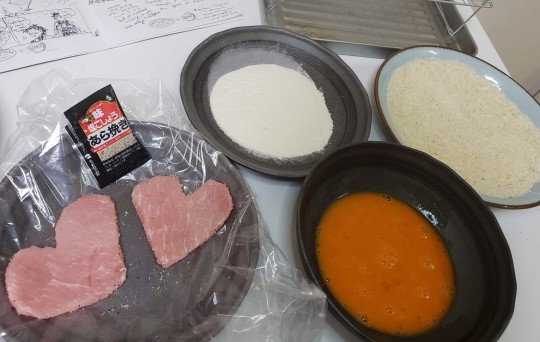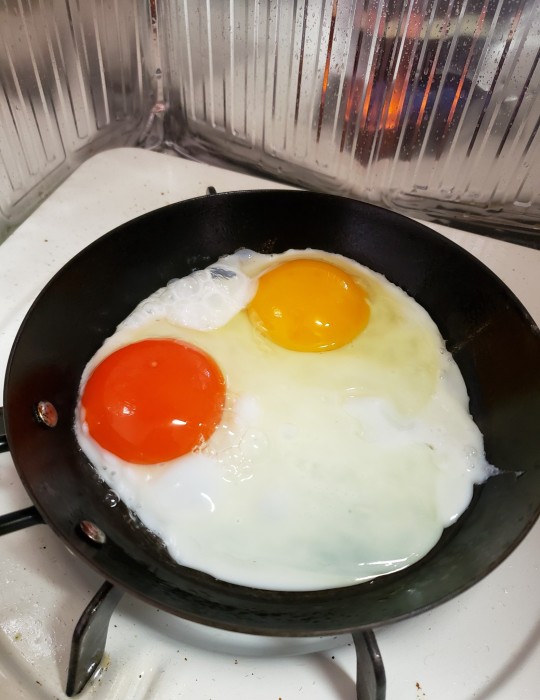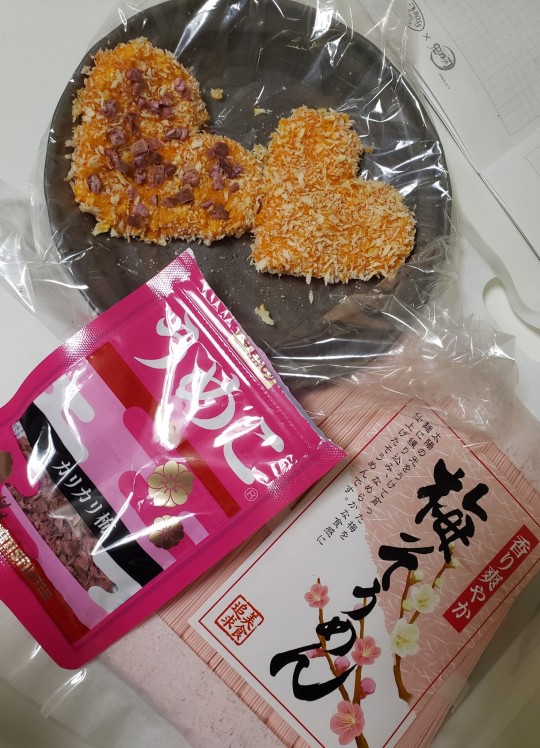#but you can't eat organic eggs and fancy flour
Text

Deep-fried pork cutlet, aka tonkatsu, was one of the food trends that took hold in Meiji and Taisho times. Fanbook #1 tells us Mitsuri was a big fan, so I knew I had to try making it at some point. With cherry blossoms being so brief, the time was now.

Unlike my last Kimetsu Kitchen experiment with fried food, this one turned out to be a huge success✨🌸💕😻😍💓💖✴️💐
First off, I rarely eat katsu.
Ever since I was little, I have never been able to stand big chunks, or even tiny chunks of fat on my meat, and katsu is usually made with cuts that have huge chunks of fat all down at least one side and all around the edges. Rather than trying to explain to people that I enjoy meat but only the very lean parts of meat and this cut's okay but that one's not, I usually just ask for something else entirely so as not to cause a fuss. But, if I'm the one cooking, I trim off as much fat as I want! Bwahaha! However, for the usual approach to tonkatsu, it's recommended that you just cut some slits in the meet when you tenderize it.
I wound up being very pressed for time on this bentou, so I did my prep on the meat the day before and used the excess meat in an earlier meal so as not to be too wasteful. I also tenderized my meat in advance. If you do not have a meat tenderizer (a mallet with this specific purpose to pound raw meat and terrorize its tough proteins into tender submission), you can also use a rolling pin.
A rolling pin? I don’t cook, what makes you think I bake? I don’t have a rolling pin.
Well then.
Meat, meet Mitsuri.

...Meat-suri.
I found it pretty easy to flatten them and make them easy to cut as I pleased. They were very cooperative. ^_^
The following morning, I knew I was likely to get stressed trying out a new recipe, especially one with deep frying a raw meat, so I prepped most of the rest of my bentou first, cleaned up my work station, got my self organized, had my instructions written on paper and a clear image in my mind of what steps I would take, and then went for it.
The steps:
1. With the non-dominant hand, coat the cutlet in flour, tap off the excess.
2. With the same hand, dip in beaten egg.
3. With the same hand, transfer it to the panko (breadcrumbs). Use the clean handy to bury it in panko.
4. Repeat steps 1-3 to give it a second coat.
5. Let rest for 10 minutes (while you clean up and prep the oil).

"Senpai!" you might be shouting, "What is wrong with your egg??"
Let's pause here to talk a bit about the ingredients. I decided to go with the fancy brand name eggs because I was like, sure, why not keep the Haikara theme. Specifically, "Akadama Bijin, Haikara-san," the name of a small local Kyoto brand, but there are other brands producing the same type of fancy Noko (or Noukou, if you prefer) egg, with reddish-orange yolks. To display the difference, here's my breakfast yesterday:

Noko eggs are talked up for how they have deeper flavor and are more nutritious, and try as I might to see if they actually have Taisho ties (given the Haikara reference), I could find no history of when these eggs started being produced (but I found out that eggs were only used as offerings for centuries but Japanese commoners only started eating them in the Edo period, so that's interesting). The true is, there's not actually much nutritional difference. It's simply that instead of a diet based on yellow food like corn, the chickens eat redder foods like carrots and paprika.
So, "Akadama" is like red yolk/gem/soul/whatever-pun-it-lends-itself-to-for-being-written-in-hiragana, and "bijin" is "a beauty" so they might be using marketing tactics to imply that supposedly extra nutritious Noko eggs will make you beauty. It just so happens my panko brand is called Karatto Bijin, so like... I can't help but think, "Don't buy into all this marketing, Mitsuri-chan! You're beautiful just the way you are!!"
So anyway, I followed the above steps, but forgot a secret ingredient I meant to add to the panko. I still had dried plum (ume) chips from the Daki onigiri in this Upper Moon Six bentou!! Since I don’t care for super heavy oily flavors, I thought the tartness might be nice. I added them during the resting phase to one of the cutlets. I turned out to be right that a slight bit of tartness was a very nice touch, but they burned easily.
Hmm, I guess that's in-character.

So anyway. I took a Total Concentration Breath and began the frying process.
Once again, I found it very difficult to maintain the oil temperature, especially on my not-very-good gas stove. Partway through my food thermometer began untrustworthy, so I had to go by color advice on the recipe I was following.
First dip:
160-170 C oil, until it becomes light "kitsune-iro" (fox color... but, uh, which foxes are we using as a base for this? And how long will this take? Come back here, recipe, help me! Since I'm a coward, I probably gave it longer than it needed, 1-3 minutes, didn't time it, I was watching the color and yelling at my food thermometer to work)
After the first dip, let it rest and drain. (Me, being a coward, made a tiny cut to check that it was cooked through, which it was.)
Second dip:
180 C oil. Only needs 20 to 40 seconds (thanks, recipe) to reach a "nice foxy color." O... kayyyy...
Anyway.
THEY CAME OUT AMAZING. These things tasted like good chicken nuggets. Phenomenal. Absolutely recommend.
And more than that, I was so happy they retained such a nice heart shape, because they went into the cutest, prettiest bentou I ever made!! I was fangirling so hard for it all morning!!! I am so proud of myself!!!!!
Oh? You want to see the bentou? Fu fu fu, that shall come in a different post.
To conclude the recipe story, after completing the bentou prep I freaked out about how I left very, very little time to make myself into any sort of bijin and I continued to run around like someone in the last 30 seconds of a televised cooking competition.
96 notes
·
View notes